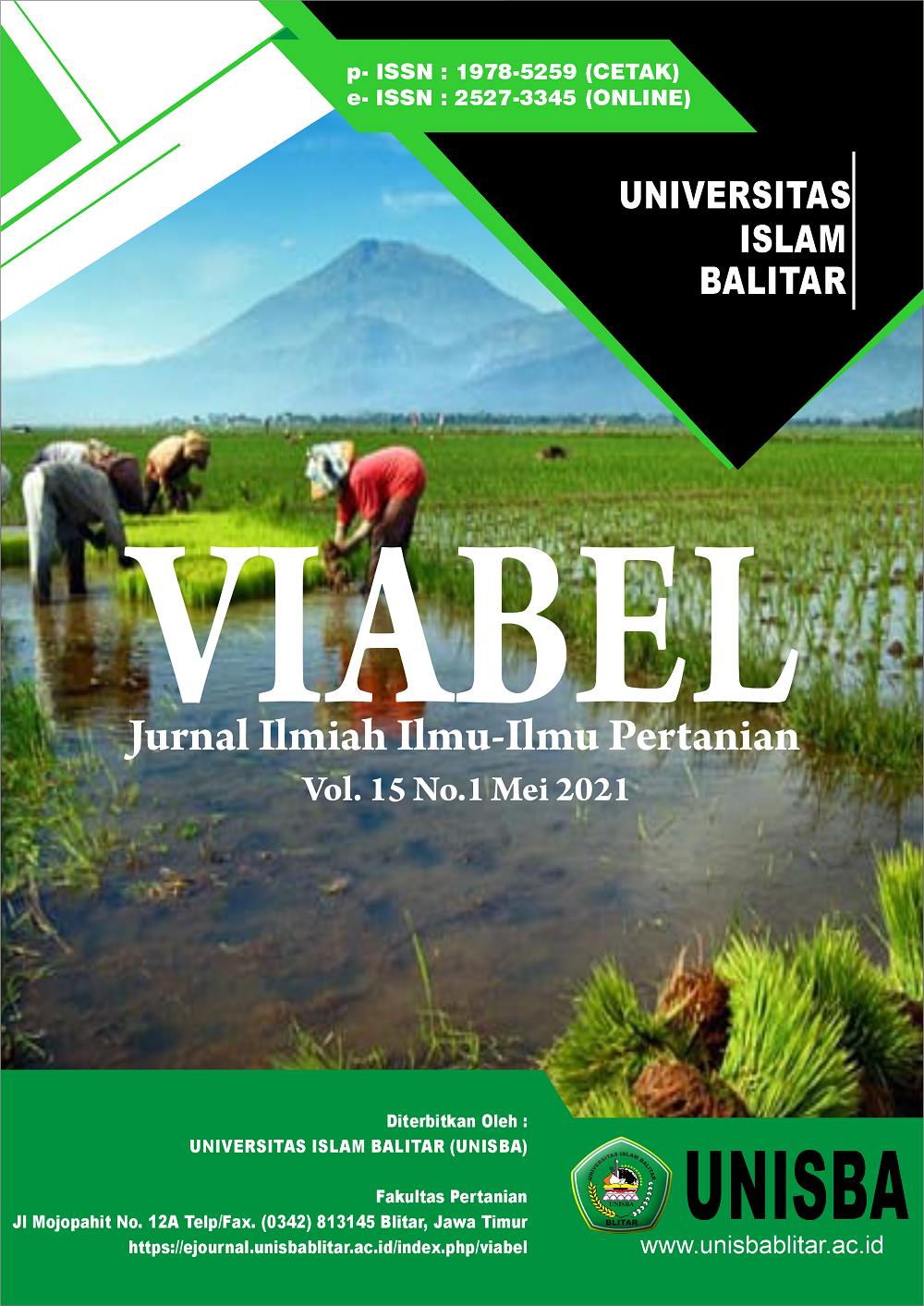THE SUPPRESSION OF TWO ENDOFIT FUNGUS AGAINST PATHOGEN IN GONDANG MANIS JAMAICAN APPLE
DOI:
https://doi.org/10.35457/viabel.v15i1.1282Keywords:
Inhibition, Fusarium sp, Metarhizium sp, Trichoderma spAbstract
This study aims to determine the ability of two endophytic fungi in Gondang Manis jamaican apple to inhibit the development of indigenous pathogenic fungi on these plants. The isolates of Trichoderma sp and Metarhizium sp were obtained from the exploration of endophytic fungi on the tissue of the Gondang Manis jamaican apple plant, while Fusarium sp was the result of exploration on the rhizosphere soil of the plant. Tests were carried out in vitro with a dual culture method using a completely randomized design (CRD) with FT (Fusarium - Trichoderma) and FM (Fusarium - Metarhizium) treatments, each with 5 replications. Determination of the resistance level based on PIRG and Bell Rating. Analysis using ANOVA p (˂0.05) and LSD test (p˃ 0.05). The results showed that Trichoderma sp has a high inhibiting ability (PIRG = 70%; Bell Rating = 2) against Fusarium sp, while Metarhizium sp is considered low (PIRG = 20.5%; Bell rating = 4). This shows that Trichoderma sp. Isolate has a better ability than Metarhizium sp in inhibiting the development of Fusarium sp. The mechanism of inhibition of the pathogen Fusarium sp by Trichoderma sp is to seize nutrients from pathogens
Key word : Inhibition, Fusarium sp, Metarhizium sp, Trichoderma sp.
Downloads
References
Athifa, Syafira, (2017). Pengaruh keragaman jamur Metarhizium anisopliae terhadap mortalitas hama Oryctes rhinoceros dan Lepidiota stigma. Skripsi. Fakultas Peternakan dan Pertanian Universitas Diponegoro, Semarang.
Dinas Pertanian Jombang, (2013). http://pertanian.jombangkab.go.id/component/co ntent/article/5-profil-disperta/258-jambu-bolvarietasgondangmanis.Website. Diakses pada tanggal 09 September 2019.
Hanudin dan Budi Marwoto. (2012). Prospek penggunaan mikroba antagonis sebagai agens pengendali hayati penyakit utama pada tanaman hias dan sayuran. Jurnal Litbang Pertanian. 31(1)
Herlinda,S , Muhamad Darma Utama , Yulia Pujiastuti, dan Suwandi. (2006). Kerapatan dan viabilitas spora Beauveria bassiana (bals.) akibat subkultur dan pengayaan media, serta virulensinya terhadap larva Plutella xylostella (linn.). J.HPT Tropika. Vol.6.No.2 : 70 – 78. September 2006
Hidayat TN, Khotimah S dan Mukarlina,(2016). Uji Antagonis Trichoderma sp. T4 Terhadap Jamur yang Diisolasi dari Daun Bergejala Bercak Pada Bibit Kelapa Sawit (Elaeis Guineensis Jacq). Jurnal Protobiont. Vol 4 (3) : 8-13.
Lelana NE, Anggraeni I dan Mindawati N, (2012). Uji antagonis Asp.ergilus sp. dan Trichoderma sp.p. Terhadap Fusarium sp., penyebab penyakit rebah kecambah pada sengon. Jurnal Penelitian Hutan Tanaman Vol 12 (1): 23-28.
Nugroho, Bayu Aji, (2012). Instruksi kerja pengujian mutu APH. Laboratorium Balai Perbenihan dan Proteksi Tanaman Perkebunan Surabaya.
Nurzannah, SE., Lisnawita, dan Darma Bakti. (2014). Potensi jamur endofit asal cabai sebagai agens hayati untuk mengendalikan layu Fusarium (Fusarium oxysp.orum) pada cabai dan interaksinya. Jurnal online Agroekoteknologi Vol. 2 No. 3:12. 30-1238.
Picardal JP, Tundag EDL, Picardal MT and Goc-ong GB, (2019). Antagonistic activity of Metarhizium anisopliae (Metschnikoff) Against Phytopathogenic Fusarium oxysporum f. sp. cubense (Schlecht.) as a biological control. CNU Journal of Higher Education Vol 13: 25-33.
Rachmawati R, Rahabistara A dan Afandhi A. (2016). Daya antagonis tiga jamur patogen serangga terhadap jamur patogen tular tanah Fusarium sp. (Hypocreales: Nectriaceae) Secara in vitro. Jurnal HPT Vol 4 (2): 93-100.
Soesanto L, (2008). Pengantar Pengendalian Hayati Penyakit Tanaman. PT Raja Grafindo Persada Jakarta.
Soesanto L, Endang Mugiastuti , Ruth Feti Rahayuniati , & Ratna Stia Dewi. (2013). Uji kesesuaian empat isolat Trichoderma spp. dan daya hambat in vitro terhadap beberapa patogen tanaman. Jurnal HPT Tropika. Vol. 13 (2) : 117–123.
Suanda, I Wayan, (2016). Karakterisasi morfologis Trichoderma sp. isolat JB dan daya antagonisme terhadap patogen penyebab penyakit rebah kecambah (Sclerotium rolfsii Sacc.) pada tanaman tomat. Prosiding Seminar Nasional MIPA Undiksha. Vol 1: 251-257.
Sari W, Suryo Wiyono, Ali Nurmansyah, Abdul Munif, Roedhy Poerwanto. (2017). Keanekaragaman dan patogenisitas Fusarium spp. asal beberapa kultivar pisang. Jurnal Fitopatologi Indonesia. Vol 13 (6) : 216–228.
Suhadi A, Sumardji, Daroini A, (2019). Strategi pengembangan agribisnis jambu Gondang Manis (Syzygium malances) di kabupaten Jombang. Agrosaintifika: Jurnal Ilmu-Ilmu Pertanian Vol 1 (2): 58-67.
Sundari Aan , Siti Khotimah , Riza Linda. (2014). Daya antagonis jamur Trichoderma sp. terhadap jamur Diplodia sp. penyebab busuk batang jeruk Siam (Citrus nobilis). Jurnal Protobiont. Vol 3 (2): 106 - 110.
Supyani. 2017. Mikovirus, pengembangannya sebagai agens pengendali hayati Mycoviruses. Jurnal Perlindungan Tanaman Indonesia. Vol. 21 (1) : 1–9.
Wardika, Citra Mayang, Suryanti, dan Tri Joko. (2014). Eksplorasi bakteri yang berperan sebagai agens pengendali hayati Fusarium solani dan Meloydogyne incognita pada lada. Jurnal Perlindungan Tanaman Indonesia Vol. 18 (2) : 89–94.
Yulianti T, (2013). Pemanfaatan endofit sebagai agensia pengendali hama dan penyakit tanaman. Buletin Tanaman Tembakau, Serat dan Minyak Industri Vol 5 (1) : 40-49.
Downloads
Published
Issue
Section
License
Copyright (c) 2021 VIABEL: Jurnal Ilmiah Ilmu-Ilmu Pertanian

This work is licensed under a Creative Commons Attribution-ShareAlike 4.0 International License.
Authors who publish with this journal agree to the following terms:
- Copyright on any article is retained by the author(s).
- The author grants the journal, right of first publication with the work simultaneously licensed under a Creative Commons Attribution License that allows others to share the work with an acknowledgment of the work’s authorship and initial publication in this journal.
- Authors are able to enter into separate, additional contractual arrangements for the non-exclusive distribution of the journal’s published version of the work (e.g., post it to an institutional repository or publish it in a book), with an acknowledgment of its initial publication in this journal.
- Authors are permitted and encouraged to post their work online (e.g., in institutional repositories or on their website) prior to and during the submission process, as it can lead to productive exchanges, as well as earlier and greater citation of published work.
- The article and any associated published material is distributed under the Creative Commons Attribution-ShareAlike 4.0 International License










.png)




